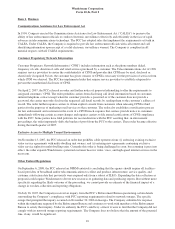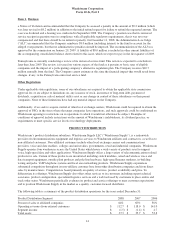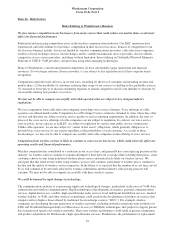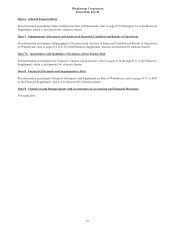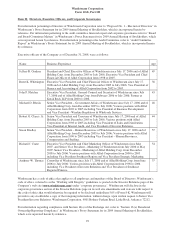Windstream 2008 Annual Report Download - page 68
Download and view the complete annual report
Please find page 68 of the 2008 Windstream annual report below. You can navigate through the pages in the report by either clicking on the pages listed below, or by using the keyword search tool below to find specific information within the annual report.
Windstream Corporation
Form 10-K, Part I
Item 1A. Risk Factors
anticipated synergies, cost savings and growth opportunities through the successful integration of the businesses of
acquired companies with those of Windstream. Even if we are successful integrating the businesses of acquired
companies, there can be no assurance that these integrations will result in the realization of the full benefit of the
anticipated synergies, cost savings or growth opportunities or that these benefits will be realized within the expected
time frames. For example, the elimination of duplicative costs may not be possible or may take longer than anticipated,
benefits from the transaction may be offset by costs incurred in integrating the companies, and regulatory authorities
may impose adverse conditions on the combined business in connection with granting approval for the merger.
Windstream’s relationships with other communications companies are material to its operations and their financial
difficulties may adversely affect Windstream.
Windstream originates and terminates calls for long distance carriers and other interexchange carriers over
Windstream’s network in exchange for access charges that represent a significant portion of Windstream’s revenues.
Should these carriers go bankrupt or experience substantial financial difficulties, Windstream’s inability to timely
collect access charges from them could have a negative effect on Windstream’s business and results of operation.
Disruption in our networks and infrastructure may cause us to lose customers and incur additional expenses.
To be successful, we will need to continue to provide our customers with reliable service over our networks. Some of
the risks to our networks and infrastructure include: physical damage to access lines, breaches of security, capacity
limitations, power surges or outages, software defects and disruptions beyond our control, such as natural disasters and
acts of terrorism. From time to time in the ordinary course of business, we will experience short disruptions in our
service due to factors such as cable damage, inclement weather and service failures of our third party service providers.
We could experience more significant disruptions in the future. We could also face disruptions due to capacity
limitations if changes in our customers’ usage patterns for our high-speed Internet services result in a significant
increase in capacity utilization, such as through increased usage of video or peer-to-peer file sharing applications.
Disruptions may cause interruptions in service or reduced capacity for customers, either of which could cause us to lose
customers and incur expenses, and thereby adversely affect our business, revenue and cash flows.
Weak economic conditions may decrease demand for our services.
We could be sensitive to economic conditions and downturns in the economy. Downturns in the economy and vendor
concentration in the markets we serve could cause our existing customers to reduce their purchases of our basic and
enhanced services and make it difficult for us to obtain new customers.
Key suppliers may experience financial difficulties that may impact Windstream’s operations.
Windstream purchases a significant amount of equipment from key suppliers to maintain, upgrade and enhance our
network facilities and operations. Should these suppliers experience financial difficulties, it could adversely affect our
business through increased prices to source purchases through alternative vendors or unanticipated delays in the
delivery of equipment and services purchased.
Adverse developments in our relationship with our employees could adversely affect our business, financial
condition or results of operations.
As of December 31, 2008, approximately 1,813 of our employees, or 25 percent of all of our employees, at various
sites were covered by collective bargaining agreements. Our relationship with these unions generally has been
satisfactory, but occasional work stoppages have occurred. Within the last five years, one work stoppage occurred at
our facility in Lexington, Kentucky, which involved approximately 350 employees and lasted approximately 120 days.
Any work stoppages in the future could have a material adverse effect on our business, financial condition or results of
operations.
We are currently party to 21 collective bargaining agreements with several unions, which expire at various times. In
addition, the proposed Employee Free Choice Act (“EFCA”), if enacted, could increase organizational activity at
locations where employees are currently not represented by a labor organization. Of our existing collective bargaining
agreements, 2 agreements covering a total of approximately 361 employees as of December 31, 2008 are due to expire
20


